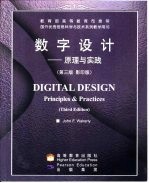图书介绍
数字设计 原理与实践 英文pdf电子书版本下载

- John F. Wakerly 著
- 出版社: 北京:高等教育出版社
- ISBN:7040100428
- 出版时间:2001
- 标注页数:946页
- 文件大小:69MB
- 文件页数:971页
- 主题词:
PDF下载
下载说明
数字设计 原理与实践 英文PDF格式电子书版下载
下载的文件为RAR压缩包。需要使用解压软件进行解压得到PDF格式图书。建议使用BT下载工具Free Download Manager进行下载,简称FDM(免费,没有广告,支持多平台)。本站资源全部打包为BT种子。所以需要使用专业的BT下载软件进行下载。如 BitComet qBittorrent uTorrent等BT下载工具。迅雷目前由于本站不是热门资源。不推荐使用!后期资源热门了。安装了迅雷也可以迅雷进行下载!
(文件页数 要大于 标注页数,上中下等多册电子书除外)
注意:本站所有压缩包均有解压码: 点击下载压缩包解压工具
图书目录
1 INTRODUCTION 1
1.1 About Digital Design 1
1.2 Analog versus Digital 3
1.3 Digital Devices 6
1.4 Electronic Aspects of Digital Design 7
1.5 Software Aspects of Digital Design 9
1.6 Integrated Circuits 12
FOREWORD 15
1.7 Programmable Logic Devices 15
1.8 Application-Specific ICs 16
PREFACE 17
1.9 Printed-Circuit Boards 18
1.10 Digital-Design Levels 18
1.11 The Name of the Game 22
1.12 Going Forward 23
Drill Problems 24
2 NUMBER SYSTEMS AND CODES 25
2.1 Positional Number Systems 26
2.2 Octal and Hexadecimal Numbers 27
2.3 General Positional-Number-System Conversions 29
2.4 Addition and Subtraction of Nondecimal Numbers 32
2.5 Representation of Negative Numbers 34
2.6 Two s-Complement Addition and Subtraction 39
2.7 Ones -Complement Addition and Subtraction 44
2.8 Binary Multiplication 45
2.9 Binary Division 47
2.10 Binary Codes for Decimal Numbers 48
2.11 Gray Code 51
2.12 Character Codes 53
2.13 Codes for Actions, Conditions, and States 53
2.14 n-Cubes and Distance 57
2.15 Codes for Detecting and Correcting Errors 58
2.16 Codes for Serial Data Transmission and Storage 69
References 73
Drill Problems 74
Exercises 76
3 DIGITAL CIRCUITS 79
3.1 Logic Signals and Gates 80
3.2 Logic Families 84
3.3 CMOS Logic 86
3.4 Electrical Behavior of CMOS Circuits 96
3.5 CMOS Steady-State Electrical Behavior 99
3.6 CMOS Dynamic Electrical Behavior 113
3.7 Other CMOS Input and Output Structures 123
3.8 CMOS Logic Families 135
3.9 Bipolar Logic 145
3.10 Transistor-Transistor Logic 156
3.11 TTL Families 166
3.12 CMOS/TTL Interfacing 170
3.13 Low-Voltage CMOS Logic and Interfacing 171
3.14 Emitter-Coupled Logic 175
References 183
Drill problems 184
Exercises 188
4 COMBINATIONAL LOGIC DESIGN PRINCIPLES 193
4.1 Switching Algebra 194
4.2 Combinational-Circuit Analysis 209
4.3 Combinational-Circuit Synthesis 215
4.4 Programmed Minimization Methods 236
4.5 Timing Hazards 244
4.6 The ABEL Hardware Description Language 249
4.7 The VHDL Hardware Description Language 264
References 298
Drill Problems 301
Exercises 304
5 COMBINATIONAL LOGIC DESIGN PRACTICES 311
5.1 Documentation Standards 312
5.2 Circuit Timing 330
5.3 Combinational PLDs 337
5.4 Decoders 351
5.5 Encoders 376
5.6 Three-State Devices 385
5.7 Multiplexers 398
5.8 Exclusive-OR Gates and Parity Circuits 410
5.9 Comparators 419
5.10 Adders, Subtractors, and ALUs 430
5.11 Combinational Multipliers 446
References 455
Drill Problems 456
Exercises 459
6 COMBINATIONAL-CIRCUIT DESIGN EXAMPLES 467
6.1 Building-Block Design Examples 468
6.2 Design Examples Using ABEL and PLDs 479
6.3 Design Examples Using VHDL 500
Exercises 527
7 SEQUENTIAL LOGIC DESIGN PRINCIPLES 529
7.1 Bistable Elements 531
7.2 Latches and Flip-Flops 534
7.3 Clocked Synchronous State-Machine Analysis 550
7.4 Clocked Synchronous State-Machine Design 563
7.5 Designing State Machines Using State Diagrams 584
7.6 State-Machine Synthesis Using Transition Lists 591
7.7 Another State-Machine Design Example 594
7.8 Decomposing State Machines 602
7.9 Feedback Sequential Circuits 604
7.10 Feedback Sequential-Circuit Design 615
7.11 ABEL Sequential-Circuit Design Features 627
7.12 VHDL Sequential-Circuit Design Features 641
References 644
Drill Problems 646
Exercises 650
8 SEQUENTIAL LOGIC DESIGN PRACTICES 659
8.1 Sequential-Circuit Documentation Standards 660
8.2 Latches and Flip-Flops 666
8.3 Sequential PLDs 681
8.4 Counters 693
8.5 Shift Registers 712
8.6 Iterative versus Sequential Circuits 747
8.7 Synchronous Design Methodology 750
8.8 Impediments to Synchronous Design 757
8.9 Synchronizer Failure and Metastability 764
References 784
Drill Problems 786
Exercises 788
9 SEQUENTIAL-CIRCUIT DESIGN EXAMPLES 795
9.1 Design Examples Using ABEL and PLDs 796
9.2 Design Examples Using VHDL 813
Exercises 829
10 MEMORY, CPLDS, AND FPGAS 831
10.1 Read-Only Memory 832
10.2 Read/Write Memory 854
10.3 Static RAM 854
10.4 Dynamic RAM 866
10.5 Complex Programmable Logic Devices 872
10.6 Field-Programmable Gate Arrays 882
References 891
Drill Problems 892
Exercises 892
11 ADDITIONAL REAL-WORLD TOPICS 895
11.1 Computer-Aided Design Tools 895
11.2 Design for Testability 902
11.3 Estimating Digital System Reliability 908
11.4 Transmission Lines, Reflections, and Termination 912
References 920
INDEX 923